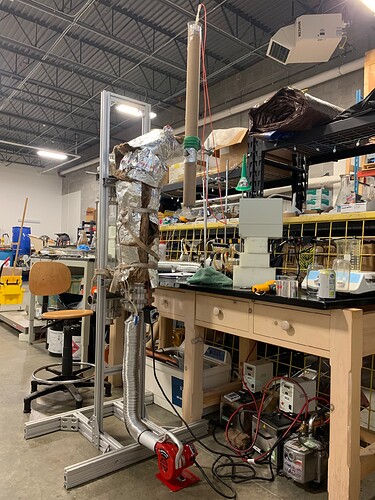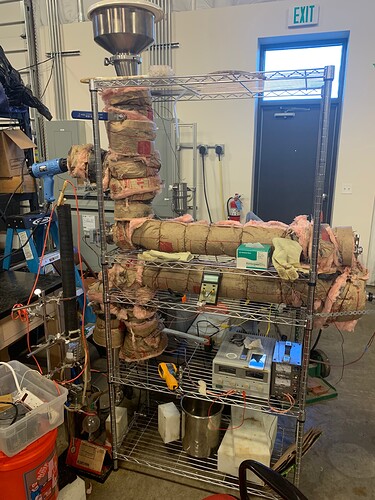have you tried a Terp and cannabinoid distillation of the rosin?
Is there any other explanation for co2 being a thing beyond PT Barnum?
From my understanding there are no benefits over a solvent based extraction, or even mechanical
We run CO2 with ethanol winterization without a C1D2. The small volumes of ethanol required for process don’t interfere with fire codes.
Subcritical extraction for terpenes is something not as easily replicable with other methods. The main use of CO2 is easy vape pens.
I like the mct oil route personally, but it’s weird how many people say mct oil is bad for them. I dunno if that’s just low-grade mct oil or if it’s just got allergens.
Hot CBD distillate is a funny idea because of the low price of hemp oil but I stop liking it the longer I think about it.
Maybe we could pull off steam distillation with our solvent extractor… it’s a precision x40. And then short path the water out.
Some of the team thought I’d be doing terp and cannabinoid distillation of the rosin but there’s just not enough and, imo, rosin is a better product than distillate.
Technically, I’ve got two teledyne pumps in my garage. Each could hold 20 gallons of co2 at 5,000psi but I don’t have the rest of the system. For what it’s worth, some of my buddies in Desert Hot Springs used to do a cold co2 extract and then pour the oleoresin straight into the pope before rectifying in a brinstrument. So no ethanol.
There’s a lot of hand-me-down stuff just collecting dust in a warehouse, it’s not a deep pockets type of situation.
Maybe.
Do you have the steam generator?
The hutzpah to build one?
Pretty sure it would be easier to use it with oil (MCT/Coconut/Olive/hemp seed).
See: Lipid infusion with hydrocarbon material columns
Couple of plumbing mods that would make it easier. Be happy to walk you through them.
Back in California I remember seeing products like infused olive oil at the dispensary. I remember them not selling but assumed it was due to the bad label which only reported the quantity of flower extracted instead of the potency.
Running MCT/Coconut/Olive/hempseed oil is all fine and well, but it lends directly to why the extraction is apart of the product formulation since each oil limits what products can be made from it.
As much fun as it will be to make those steam modifications, I first need to do more research on whether this is a viable regulatory work around. It’s the county that’s holding the red tape at this point so the state could be amenable if this solution isn’t already in the clear.
Even though this idea might not be viable, I’m tempted to try to distill the terps off biomass until there’s enough to do the solvent extraction with it to get the cannabinoids.
sounds like a decent plan
there are rumors it’s not that hard ![]()
success is high value.
…and so long as you don’t destroy the cannabinoids along the way (and document in METRC that “nah, we keeping this shit, it ain’t extracted fully yet”), you’ve got little to loose.
@batsona can you tell us more about this vapor static magnetic extraction system you helped to design?
The ‘static’ part – using an electrostatic precipitator to collect the product mist – was my idea. (ESP is a tried and true, scalable method for collecting liquid or solid particles.) But then our company split and the half that I chose to stick with ultimately never had the resources or to pursue the pilot system I put together. The other half did, got a patent, and may or may not have sold their behemoth system. Now, my view is there’s another group out there (see goloxley.com) that has a better handle on the direct biomass distillation process that isn’t even using ESP.
its probably not a scalable solution but… I toured a farm once that water cured whole plants for lipid/lipid extraction they would dip fresh harvested plants in a mix of sodium borate and hydrogen peroxide to supposedly kill any spores on the plants. than stacked the plants in 55 gallon drums in a walk in cooler filled the drums with filtered water and let soak for 10 days changing the water once a day, after 10 days the plants were hung to dry in a in a heated room with a dehumidifier and dried like normal. they used squalene oil, and c8 mct for there extractions in heated kettles and filtered with a bladder style wine press. decarbed in the oil called it pasteurization bottled and sold. it was a pretty sketchy outfit but honestly the tincture was light in color and a decent flavor. just so much waisted water.
What was the approximate size/scale of the process that you worked on? I see many ESPs are either behemoths or are used for air purification. I worked on gel electrophoresis in college and this ESP is very similar.
I’m not sure if this technique will work at the 10lbs biomass level, but it’s interesting.
right on! Yes from what I can see gel electrophoresis is moving molecules at different rates based on their charges & masses. ESP on the other hand attaches charge to the surfaces of tiny particles. That’s the thing – direct biomass distillation of cannabinoids tends to produce a ‘fog’ or ‘mist’, perhaps due to solid material particles that act as nuclei–as opposed to a molecularly homogenous ‘vapor’ (I think the commercial offering that uses ESP, cited above, is another misnomer)
Here’s my experiments over the course of about five months June to August 2019.
first tests:
larger batch scale (maybe 4 lbs in the column)
ESP crude collection in action:
semi continuous test rig–never got it dialed in (never was able to sort out particle separation from the vapor/mist stream) - figure it could have hit 50 lbs per hour or so.
Water plays an interesting part in lipid infusion… tends to precipitate gums in my experience. I can push carrier oil through biomass, then after letting the oil sit for several days, particles while appear and drop to the bottom. My guess is these are gums that have affinity for both water and oil – they are a pain to filter out but hardly impossible.
Lot of lipid infusion retailers carry out infusions in crock pots filled with water and carrier oil, decarboxylating and infusing all at the same time. No clue how they then separate the phases and the remove water absorbed in the infused oil phase.
I think it’s neat you mention pasteurization… I have tests showing that moldy/microbe-laden biomass can be infused into carrier oil that, after decarboxylation, comes back clean.
standard trick for the crockpot crew is to freeze one or other of your layers.
with butter it’s the oil. with MCT its the water.
getting the rest out is most often ignored would be my guess.
Ah right on I always forget this. Pretty sure I’ve seen that freezing the infusion would also be best for preservation.
For the rest of the water I’ve thought about sieves but never tried to implement. Regeneration (preferably without solvent) was a mental hurdle I never got past. Na2SO4?
Loxley Systems - seems like our solution might be a good option for you. There’s no solvent and no downstream processing. Our systems move from plant to distillate in 45 minutes and remove terpenes before any high temps. We can process fresh, frozen, or dried.
720-509-9707
Solventless heat and gas extraction? Checked out your website confused any chance you could elaborate?
see: Thoughts on distillation directly from plant material. for the basic concepts.
You have my attention!


